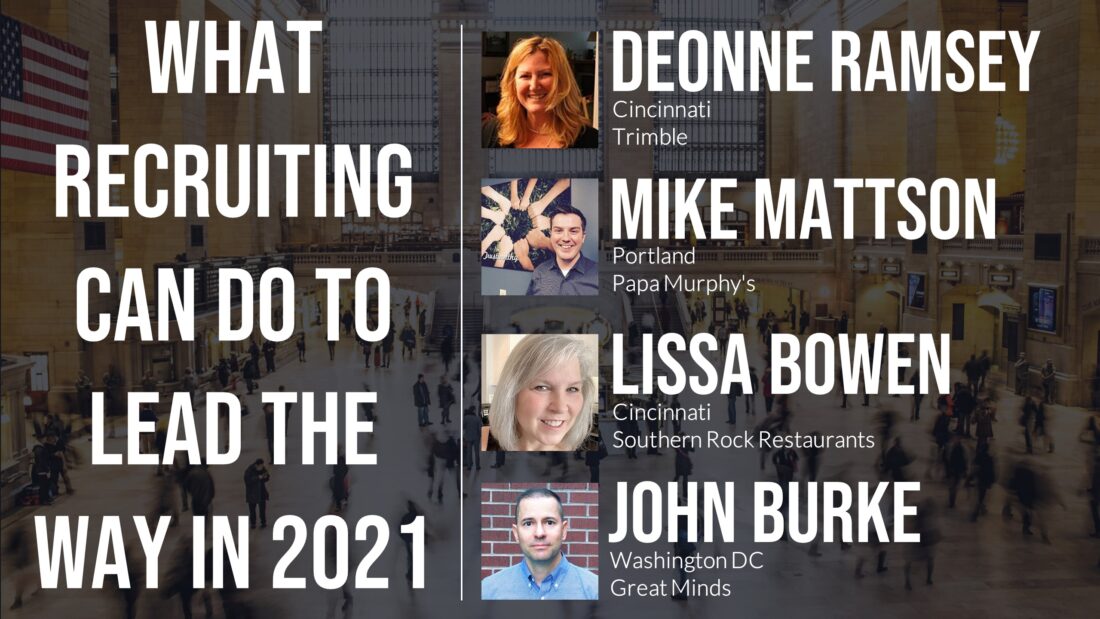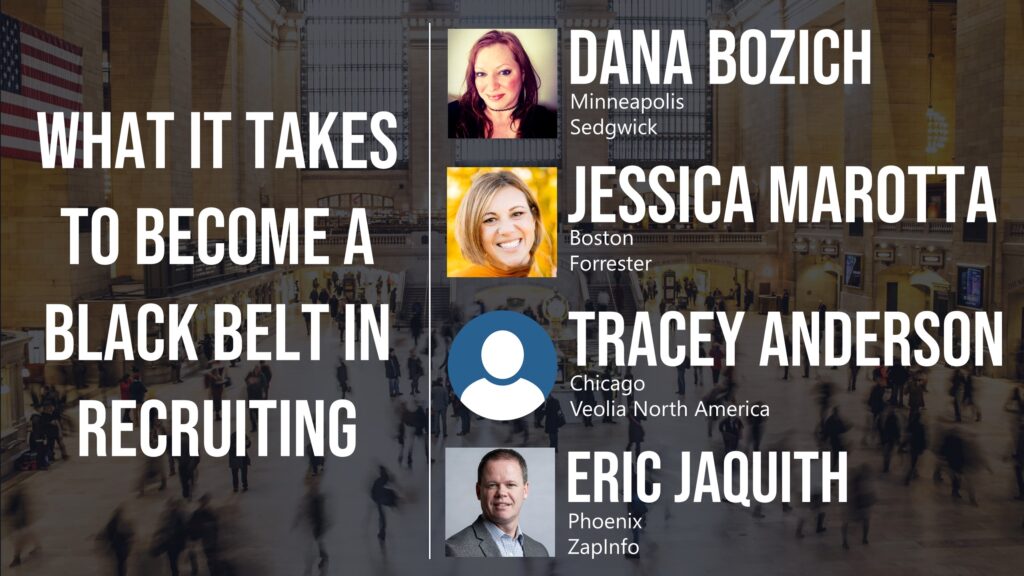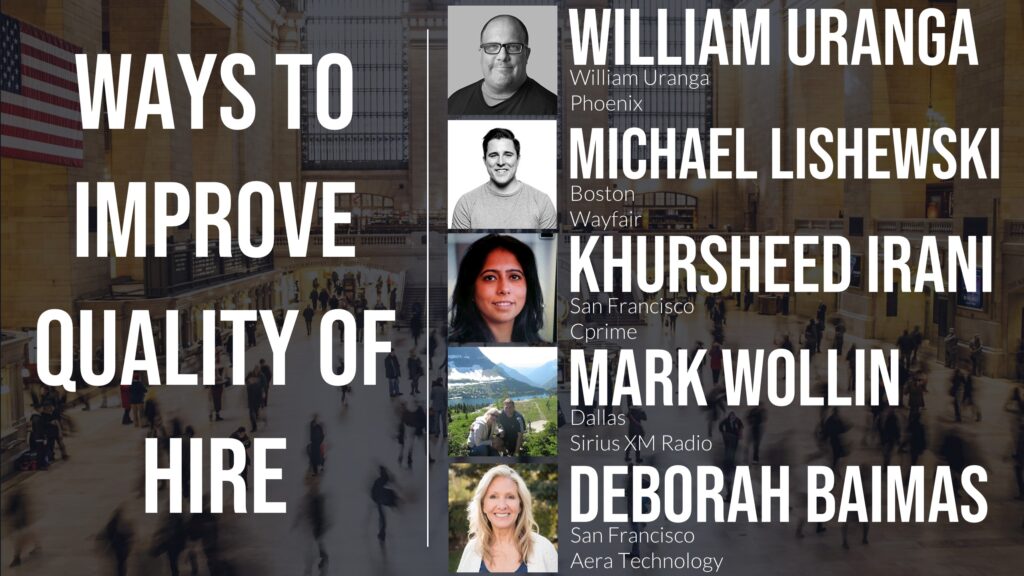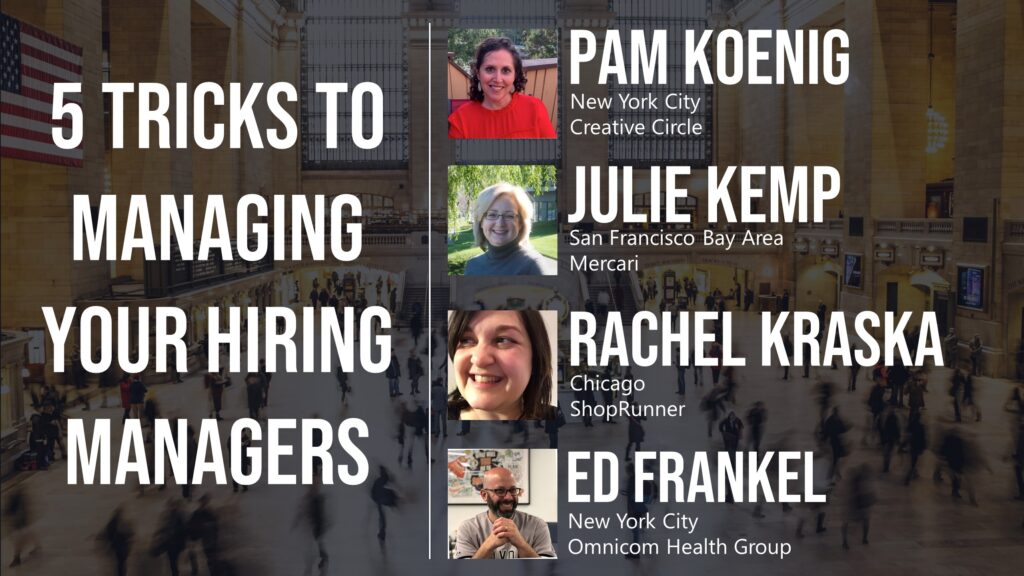As we leave the year 2020 behind us, 2021 will certainly be a year where companies need to be thoughtful and strategic with their recruiting plans for the year.
In today’s round-table session, our panelists talk about how Talent Acquisition and Recruiting teams can help their companies make strategic plans and decisions as they make their way through the year.
Listen in on what our panelists have to say.
This event is part of the “Let’s Talk Recruiting” series where a panel of recruiting practitioners get together online and have a conversation on a variety of topics related to corporate recruiting.
Click to Play the Recording
Our Panelists…
| Name & LinkedIn Profile | Group | Title | Company |
We asked our attendees, “What is one thing that Talent Acquisition and Recruiting teams need to be thinking about in 2021?”
Here are their answers:
Chat Messages from the Session…
10:05:52 >> From Shawn Watzka : Could you elaborate on what you mean by grow socially?
10:09:33 >> From Steven Rosenblum : Hello everyone! I have great success and experience in TA and HR with immediate availability to join an organization, as my contract position concluded last week. Please link with me at linkedin.com/in/stevenrosenblum to connect and/or download my profile and resume. Let’s talk!!
10:10:04 >> From John Sullivan : Great insight Deonne!!
10:10:42 >> From Catherine Hansen : Totally agree Sean – it does come down to recruiting always
10:12:34 >> From Catherine Hansen : @Deonne, does the TABP have recruiting OKRs, or how is success measured in these roles?
10:12:56 >> From Jeanne Amey : We would coach our hiring managers to post their openings out into their social networks –
10:13:59 >> From Jeanne Amey : what is OKR?
10:14:08 >> From Jeanne Amey : thanks!
10:16:58 >> From Steven Rosenblum : You are right on Lissa! TA should be part of the business. We need to be incorporated into what the business is doing, what the business forecasts going forward, and business leaders participate in TA activities.
10:20:26 >> From Jeanne Amey : Good segmentation Sean, each phase of the application process can have highs and lows – we did candidate mapping to define those high/low points and doing things to mitigate the low points and keep engagement building
10:22:10 >> From Kathlene Whinnery : Great comment about the rejected candidates; good honest feedback, kept short and simple and constructive, is usually well received
10:22:11 >> From Steven Rosenblum : Thanks, Mike. Data shows that positive candidate experiences from recruiting through onboarding and beyond matter to hiring success, individual productivity, retention and turnover, company culture and company performance. Like Jeanne posted, by mapping and breaking these areas down and analyzing them for possible improvement and endorsement can impact this area.
10:22:34 >> From Catherine Hansen : +1 re rejected candidates. The best rejection I personally received was a video clip from the CEO expressing that the target skill sets they had identified as critical, had changed. It was personal and amazing
10:23:46 >> From Marvin Smith to All panelists : How do you prepare mentally to reject 99/100 people? How do you do that at scale? How do you handle rejection with grace and give them some hope?
10:26:04 >> From Catherine Hansen : Re Glassdoor…I think it’s both blessing and curse. I do get a bit wary if all I see are amazingly positive ratings
10:27:21 >> From Shawn Watzka : Mike made a great point about recognizing your negative feedback on glassdoor.
10:32:07 >> From Mike Mattson : Good question Marvin! Its not easy to reject 99 people with families, dreams, and their own lives, but on the other hand we can’t hire everyone! I try to leave our last point of contact as an invitation for future connection. They already have your contact info, maybe even connected on LinkedIn, but a rejection doesn’t have to be the end of the relationship. Did that answer your question?
10:33:47 >> From Catherine Hansen : @Lisa, I love the way you’re thinking about investment in existing employees.
10:34:59 >> From Catherine Hansen : I have found this more difficult in the tech industry (technical requirements for roles)
10:42:55 >> From Jeanne Amey : Right on with that Sean – entry level is easier to show D&I, the company starts to show it’s bias with who gets promoted/retained
10:44:32 >> From Catherine Hansen : What exactly is meant by “equity” in this context?
10:49:00 >> From Catherine Hansen : THANK YOU!
10:49:04 >> From John Sullivan : thank you
10:49:08 >> From Jeanne Amey : Great discussion – thank you!
10:49:08 >> From Marie deGroh : Thank you all!
10:49:12 >> From Maureen Daly to All panelists : Thanks everyone-
10:49:21 >> From Beverly Royall to All panelists : Great conversation!
10:49:27 >> From Jeanne Amey : Same to you!
Some of the attendees…
| Name & LinkedIn Profile | Group | Title | Company |



